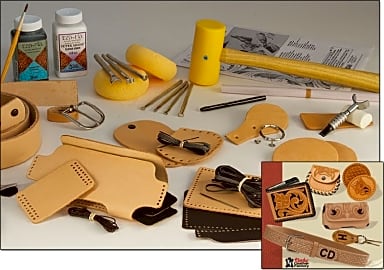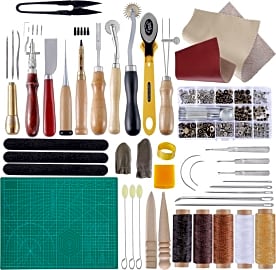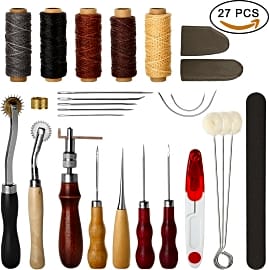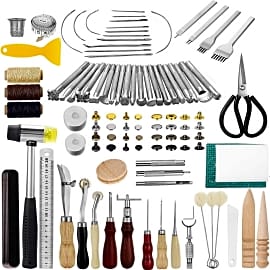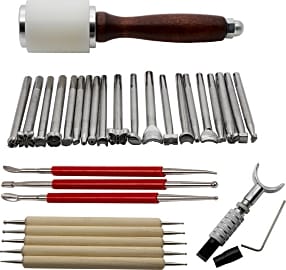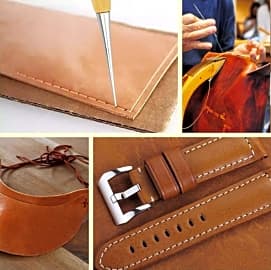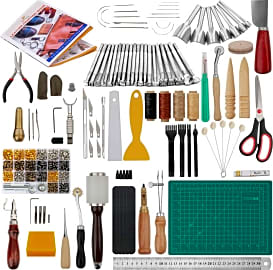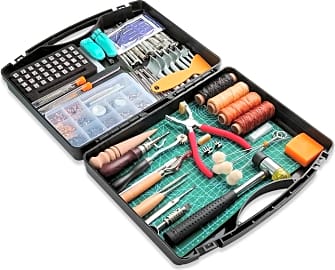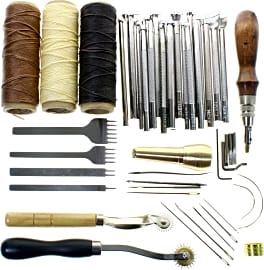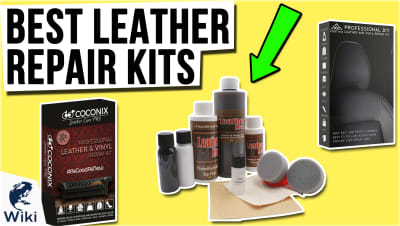The 10 Best Leather Working Tool Kits

This wiki has been updated 38 times since it was first published in March of 2017. If you want to make a belt, wallet or handbag from scratch, but you're not certain what you need to get started, take a look through these leather working tool kits. Our comprehensive selection offers sets of various sizes that are suitable for everyone from complete beginners to experienced craftsmen alike, so we're sure you'll find an option that will suit your needs. When users buy our independently chosen editorial choices, we may earn commissions to help fund the Wiki.
Editor's Notes
July 23, 2020:
Pulled a few items from the rankings due to poor performance and availability issues. We modified the listing for the BigTeddy Set to indicate that it’s an affordable kit geared more towards novice users than intermediate or expert leather workers.
In evaluating options on this list, you may first want to determine whether you simply seek a set of tools, or if you’d prefer a package that includes accessories, hardware, and other project components as well. In addition to the essential tools, some kits contain stamping devices, rivets, snaps, thread, and even leather material to get started with.
To suit different needs, we added three new sets to the list with varying amounts of supplies: the Joypea Package (195 pieces), the Bagerla Craft (272 pieces), and the Dorhui Supply (356 pieces). We highlighted that the Bagerla model includes a ruler, a component not frequently found in similar kits. The Dorhui set not only comes with a carving knife, but it contains six blade replacements for when they become dull.
June 17, 2019:
Due to availability issues with the Windaze Saddle, Sotogo Hand and Tandy Leather Basic, all three of these items have been taken off the list. We updated the rankings with three new models, highlighted by the Butuze Complete, which contains 42 separate pieces — including beeswax, a cutting mat and three nail files — that help make it a prime intermediate set. One thing to keep in mind: it does not come with a guide book or instructions of any kind, so you’ll want to make sure you familiarize yourself with the tools and the relevant techniques before diving into a project.
Also added the Ampseven Model to provide a straightforward starter kit. It’s a nice choice for beginners who want to get the hang of the craft, but once a new user’s skills have progressed, it allows for more challenging, detailed work that will keep experienced people engaged as well.
With 59 pieces, the Caydo Craft is one of the most comprehensive options available. In evaluating this model, we noted that the tools in this kit are of average quality, and several may require sharpening somewhat frequently to maintain efficacy. We dropped its position in the rankings slightly as a result.
Special Honors
MacPherson Craft 55510 Once you’ve graduated from novice status and put a substantial amount of blood, sweat and tears into the hobby, this is the type of set that will take you to the next level. You can begin to add your own personal style to your creative pieces using the bottles of antique leather stain and professional dye that come with this kit. macphersonleather.com
Lee Valley Leatherworking While Lee Valley doesn’t offer multi-tool packages, you’ll find just about any item you could possibly require for a leather-working project, from shears, groovers and eyelet drivers to buckles, snaps and lacing. They do offer special kits for crafting a notebook, carry case, belt, passport kit and pen holder. leevalley.com
Lonsdale Leather Lonsdale offers three types of kits — basic, intermediate and deluxe — for leather working enthusiasts at all experience levels. They all contain a rotary punch, stitching chisel, awl and leather contact cement, while the expert set will also land you a mallet, cutting mat and some beeswax. lonsdaleleather.com
What Exactly Is Leather?
These can also be oiled for additional suppleness and protection from the elements.
Leather permeates our society at nearly every turn. We wear it on our feet, use it to keep our pants up, carry our belongings in it, sit on it, bind our books with it, and more. Like most of the products in our lives that have attained such a level of ubiquity, we tend to take it for granted. Many of us might not even understand exactly what it is. It’s animal skin, to be sure, but you can’t just go out, slaughter a cow, cut off its skin, and make a couch with it.
That’s because leather is a particularly treated form of animal skin that’s undergone a variety of processes to create the durable, naturally water-resistant leather on which we’ve come so heavily to rely. The most important of those processes is tanning.
After a given hide has been cleaned — de-haired, degreased, washed, and soaked — it’s more or less ready for the tanning process. Tanning takes its name from tannin, a certain chemical compound the acidity of which had the ability to significantly alter the proteins in animal skin. Once those proteins are altered, the skin will more or less cease its decomposition process, creating a material that could last for decades.
If tannins sound familiar to you, you may have heard them referred to in the wine making process. They’re no longer used in leather making, at least not on any industrial scale, as they were supplanted by a much less expensive and more reliable chromium solution during the Industrial Revolution. Prior to that, however, leather was theoretically edible, though you wouldn’t enjoy the flavor much. In the case of castle sieges and other episodes of great hunger, people sometimes took to boiling their leather goods and consuming them. The great film director Werner Herzog even cooked and ate one of his own shoes in a very public manner to make good on a bet with a fellow documentarian. It's not unheard of, just ill-advised.
Tanned leather is often still a few steps removed from what you see in clothing stores and on car seats. Additional processes like crusting and coloring utilize physical and chemical means to soften and finish leather goods for particular uses. These can also be oiled for additional suppleness and protection from the elements.
How To Choose The Best Tool Kit For You
Leatherworking can be a very rewarding process. Not only do you get to enjoy the satisfaction of taking a piece of raw material and shaping it to suit your desires, you also stand to save a significant amount of money compared to buying similar quality products from manufacturers or from craftsmen. And in the end, you have a tangible, durable item that you can use for a very long time, or that you can gift to a friend or loved one.
In order to get started, though, you’ll need to select one of the leatherworking kits from our list. To help you narrow down our selection, let’s take a look at some of the key components of a given set.
Of course, if you have a little more experience and your own stash of leather, you can save a little money on a set with just the tools.
Most leatherworking kits come with both practical and decorative tools. Practical tools can include strong scissors for cutting and shaping your workpiece, and awls that allow you to punch holes wherever necessary without damaging the surrounding material. These are pretty standard fare when it comes to leatherworking. It’s in the decorative tools that these sets begin to differentiate themselves from one another.
For example, some kits come with the materials you would need to create simple or intricate stitching patterns in your leather goods. These accents often take a piece of leatherwork from amateurish in appearance to downright professional. You can edge the outside of a wallet, create flowing designs along the length of a belt, and more with a specific combination of awl, needle, and thread, all provided by your kit.
Other decorative materials include rollers and stamps that can create lasting indentations in a workpiece. When leather is wet, it’s more susceptible to deformation under pressure, and you can capitalize on this feature to add all sorts of shapes and images to your work. Some kits even come with hammers specifically designed to help you impress metal stamps into the leather.
One final consideration is whether a kit comes with its own leather for you to work with. These are usually the best sets for beginners, as they include specific instructions for shaping and detailing each piece. Of course, if you have a little more experience and your own stash of leather, you can save a little money on a set with just the tools.
A Brief History Of Leather
Humans have been using animal skins as a means of protection from the elements since long before recorded history. That makes pinpointing that advent of certain techniques a little more difficult, as we have to rely on archaeological finds and carbon dating to give us a glimpse into prehistoric methods. It’s safe to say that it didn’t take long for us to realize that animal hides had a tendency to get impractically stiff in cold weather, and to rot quickly in warm and moist climates.
Stretching hides out in the sun and coating them with salt had some similar effects.
To combat this, we began to rub animal fats on the hides, presumably in an attempt to put them back in touch with the materials they contacted when the animal was alive and the skin more or less took care of itself. Primitive methods evolved from this to the use of smoke — a form of formaldehyde tanning that resulted from burning green leaves to give off specific vapors. Stretching hides out in the sun and coating them with salt had some similar effects. These methods were successful mostly due to the fact that they drew moisture out of the hide while altering the nature of its proteins.
Tanning from vegetable tannins, which gave the process its name, came about around the 8th century C.E. in Spain, and the process quickly spread throughout Europe and other neighboring regions. This would become the primary means of treating animal hides until the Industrial Revolution, when a chromium solution proved just as effective, but cost far less to produce.


